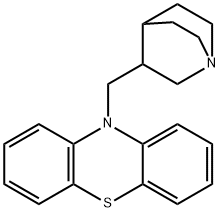Manufacturing Process
30 g of phenothiazine were added, all at once, to a suspension of 6 g of sodium amide in 240 ml of anhydrous xylene. The mixture was agitated and heated to reflux. When evolution of ammonia ceased (5 hours), 15 g of 3- chloromethyl-quinuclidine hydrochloride were added portionwise over a period of 50 minutes and reflux was then maintained for 22 hours. After cooling to room temperature, 250 ml of distilled water and 250 ml of ethyl acetate were added to the reaction mixture. The aqueous phase was decanted and extracted twice with a total of 250 ml of methyl acetate. The combined organic extracts were extracted three times with a total of 750 ml of a 10% aqueous solution of tartaric acid. The combined acid solutions were treated with 5 g of animal charcoal, filtered and rendered alkaline on an ice bath with 96 ml of 10 N aqueous caustic soda. The oil which separated was extracted three times with a total of 1.500 ml of ethyl acetate. The combined organic extracts were washed to neutrality by washing twice with a total of 1 liter of distilled water, dried over anhydrous magnesium sulfate and evaporated under reduced pressure on a water bath at 45°C. 17 g of oil were obtained which was purified by chromatography on an inert alumina column. 13.3 g of crystallized product were obtained. 10-(3-Quinuclidinyl-methyl)-phenothiazine having a MP of 130°C to 131°C was obtained by recrystallization in boiling acetonitrile.
The 3-chloromethyl-quinuclidine hydrochloride used as starting material in this process can be obtained as described by Grob and coll., Helv. Chim. Acta, 37 (1954),1689.
Biological Activity
Mequitazine is a potent, nonsedative, long-acting and selective H1 histamine receptor antagonist. Mequitazine exhibits weak anticholinergic activity.




